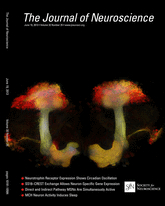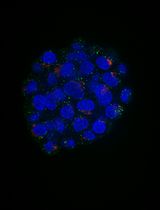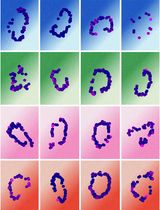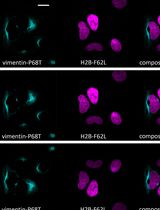- EN - English
- CN - 中文
Proteasome Assay in Cell Lysates
细胞匀浆中的蛋白酶体分析
发布: 2014年01月20日第4卷第2期 DOI: 10.21769/BioProtoc.1028 浏览次数: 13414
评审: Xuecai Ge
Abstract
The ubiquitin-proteasome system (UPS) mediates the majority of the proteolysis seen in the cytoplasm and nucleus of mammalian cells. As such it plays an important role in the regulation of a variety of physiological and pathophysiological processes including tumorigenesis, inflammation and cell death (Ciechanover, 2005; Kisselev and Goldberg, 2001). A number of recent studies have shown that proteasome activity is decreased in a variety of neurological disorders including Parkinson's disease, Alzheimer's disease, amyotrophic lateral sclerosis and stroke as well as during normal aging (Chung et al., 2001; Ciechanover and Brundin, 2003; Betarbet et al., 2005). This decrease in proteasome activity is thought to play a critical role in the accumulation of abnormal and oxidized proteins. Protein clearance by the UPS involves two sequential reactions. The first is the tagging of protein lysine residues with ubiquitin (Ub) and the second is the subsequent degradation of the tagged proteins by the proteasome. We herein describe an assay for the second of these two reactions (Valera et al., 2013). This assay uses fluorogenic substrates for each of the three activities of the proteasome: chymotrypsin-like activity, trypsin-like activity and caspase-like activity. Cleavage of the fluorophore from the substrate by the proteasome results in fluorescence that can be detected with a fluorescent plate reader.
Keywords: Nerve cells (神经细胞)Materials and Reagents
- Cells
- HEPES (Sigma-Aldrich, catalog number: H3375 )
- MgCl2 (Sigma-Aldrich, catalog number: M2670 )
- EDTA (Sigma-Aldrich, catalog number: E5134 )
- EGTA (Sigma-Aldrich, catalog number: E4378 )
- Sucrose (MP Biomedicals, catalog number: 821713 )
- DTT (Life Technologies, catalog number: 15508013 )
- Proteasome substrates [dissolved in DMSO (Sigma-Aldrich, catalog number: D8418 ) to a final concentration of 10 mM and stored frozen at -20 °C]
- PBS without Ca2+ and Mg2+ (Sigma-Aldrich, catalog number: P802)
- Coomassie Protein Assay Reagent (Thermo Fisher Scientific, catalog number: 1856209 )
- BSA protein standard (Thermo Scientific, catalog number: 23209 )
- ATP (Sigma-Aldrich, catalog number: A3377 )
- Proteasome Lysis/Assay Buffer (see Recipes)
Equipment
- 60 mm tissue culture dishes
- Rubber policeman or other type of cell scraper
- 1.7 ml microcentrifuge tube
- Black walled 96 well plates (Corning, Costar®, catalog number: 3603 )
- Clear 96 well plates (Greiner Bio-One GmbH, catalog number: 655101 )
- Sonicator (GlobalSpec, model: W-380 )
- Microcentrifuge
- Fluorescent plate reader
- Visible plate reader
Procedure
文章信息
版权信息
© 2014 The Authors; exclusive licensee Bio-protocol LLC.
如何引用
Readers should cite both the Bio-protocol article and the original research article where this protocol was used:
- Maher, P. (2014). Proteasome Assay in Cell Lysates. Bio-protocol 4(2): e1028. DOI: 10.21769/BioProtoc.1028.
-
Valera, E., Dargusch, R., Maher, P. A. and Schubert, D. (2013). Modulation of 5-lipoxygenase in proteotoxicity and Alzheimer's disease. J Neurosci 33(25): 10512-10525.
分类
神经科学 > 细胞机理
细胞生物学 > 细胞成像 > 荧光
您对这篇实验方法有问题吗?
在此处发布您的问题,我们将邀请本文作者来回答。同时,我们会将您的问题发布到Bio-protocol Exchange,以便寻求社区成员的帮助。
Share
Bluesky
X
Copy link













